Terrariums are miniature gardens enclosed in glass containers, bringing a slice of nature indoors. They create the perfect environment for plant enthusiasts to nurture greenery while doubling as a chic decor element for homes and offices. But to create a thriving terrarium, selecting the right plants is crucial. This guide will walk you through 15 of the best plants for terrariums, perfect for both open and closed environments.
Here’s everything you need to know to get started!
What Are Terrariums?
Terrariums are glass-enclosed ecosystems that serve as natural habitats for plants. There are two types of terrariums:
- Closed Terrariums: These create a humid environment, making them ideal for plants that thrive in moisture.
- Open Terrariums: A better choice for plants that prefer drier conditions.
Terrariums are low-maintenance, space-saving, and provide an excellent way to bring greenery into your life, no matter how small your space.
Now, onto the stars of the show—the 15 best plants for terrariums.
The 15 Best Plants for Terrariums:
1. Nerve Plant (Fittonia)
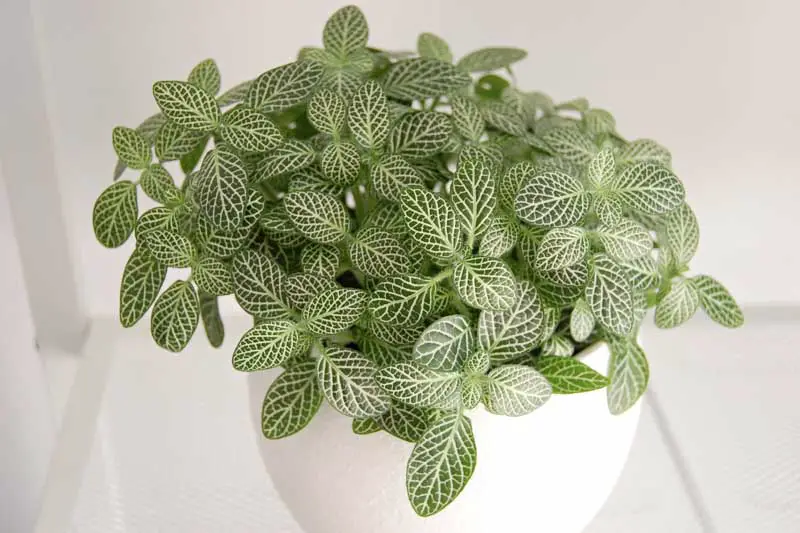
With its striking veined leaves in shades of pink, white, and green, the Nerve Plant creates a vibrant focal point in your terrarium. It thrives in the high humidity of closed terrariums, making it a top pick for beginners.
- Light: Thrives in bright, indirect sunlight, but it can adapt to low light conditions. Avoid direct sun exposure, as it can scorch the delicate, patterned leaves.
- Water: Keep the soil consistently moist but not soggy. Water when the top half-inch of soil feels dry. Overwatering can cause root rot, while underwatering may lead to droopy leaves.
- Humidity: Loves high humidity—ideal for terrariums! Mist regularly, place it near a humidifier, or set the pot on a pebble tray with water to maintain moisture.
- Temperature: Prefers 65–80°F (18–27°C). Keep it away from cold drafts, AC vents, or sudden temperature changes, which can cause leaf drop.
- Soil: Use a well-draining, peat-based mix rich in organic matter. A blend of peat moss, perlite, and potting soil works well.
- Fertilizer: Feed with a diluted, balanced liquid fertilizer once a month during the growing season (spring and summer). Avoid over-fertilizing, as it can lead to leggy growth.
- Growth Habit: A low-growing, spreading plant that makes an excellent ground cover in terrariums. Pinch back the stems to encourage bushier growth and prevent legginess.
- Bonus Tip: If your Fittonia suddenly wilts, don’t panic! A quick drink of water usually revives it within a few hours.
2. Baby’s Tears (Soleirolia Soleirolii)
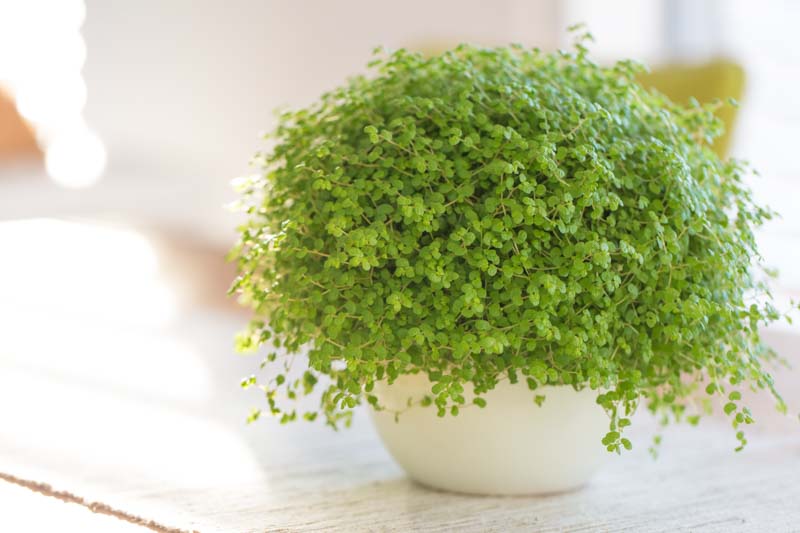
This low-growing plant forms a lush green carpet, perfect for terrarium floors. It loves moisture and thrives in the humid conditions of closed terrariums.
- Light: Prefers partial to full shade. It thrives in bright, indirect light but can tolerate lower light levels. Avoid direct sunlight, which can scorch its delicate leaves.
- Water: Keep the soil consistently moist but not soggy. Water when the top layer of soil feels slightly dry. This plant is sensitive to drying out, so don’t let it go too long without moisture.
- Humidity: Loves high humidity—perfect for terrariums! Regular misting helps keep the tiny leaves lush and prevents browning at the edges.
- Temperature: Best in 60–75°F (16–24°C). It dislikes cold temperatures and should be kept away from drafts and air conditioning vents.
- Soil: Prefers a well-draining, rich organic soil. A mix of peat moss, potting soil, and perlite works well to retain moisture without waterlogging.
- Fertilizer: Feed with a diluted liquid fertilizer every 4–6 weeks during spring and summer to promote healthy growth. Avoid over-fertilizing, as it can make the plant leggy.
- Growth Habit: A fast-spreading, mat-forming plant that creates a dense, carpet-like cover in terrariums. Regular trimming helps maintain its shape and prevents overgrowth.
- Bonus Tip: If the leaves start turning yellow or brown, it may be a sign of too much sun or inconsistent watering. Adjust its care routine accordingly to keep it fresh and vibrant!
3. Air Plant (Tillandsia)
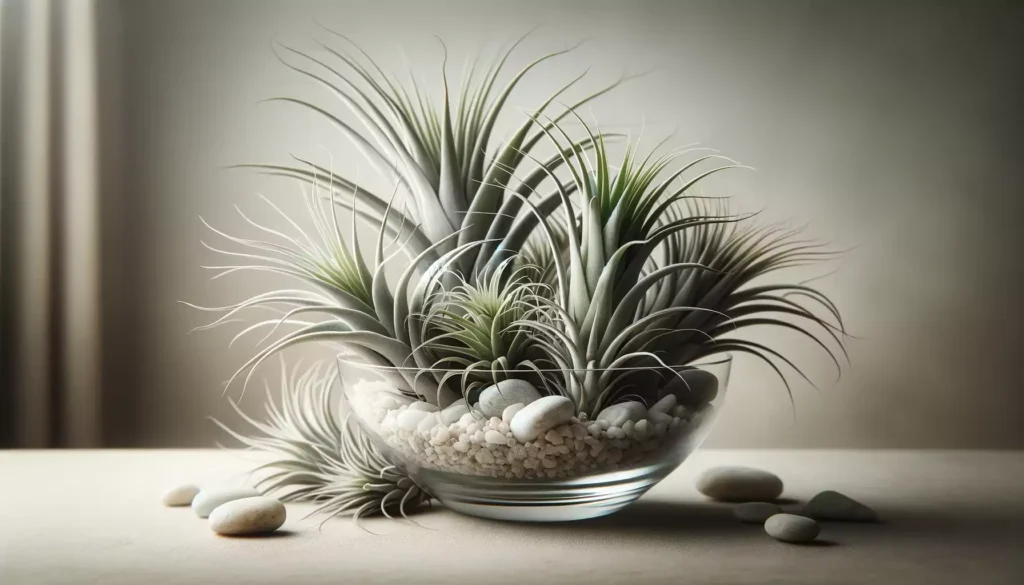
Air Plants don’t need soil to survive, making them ideal for open terrariums. With their fascinating shapes and minimal needs, they add an exotic touch to your setup.
- Light: Thrives in bright, indirect light. Place near a window with filtered sunlight or under grow lights. Avoid prolonged direct sun exposure, which can dry out the leaves.
- Water: Since they absorb moisture through their leaves, mist them 2–3 times a week or soak them in water for 20–30 minutes every 1–2 weeks. In dry climates, mist more frequently. Shake off excess water after soaking to prevent rot.
- Humidity: Prefers moderate to high humidity—perfect for terrariums! If the air is too dry, increase misting frequency.
- Temperature: Ideal range is 50–90°F (10–32°C). Keep away from cold drafts, heaters, or AC vents, which can cause dehydration.
- Air Circulation: Needs good airflow to stay healthy. If placed in a closed terrarium, open it occasionally to allow fresh air circulation.
- Fertilizer: Feed with a diluted bromeliad or air plant fertilizer once a month during the growing season (spring and summer) to encourage growth and flowering.
- Growth Habit: A unique epiphytic plant that doesn’t need soil! It can be mounted on driftwood, displayed in glass terrariums, or arranged in decorative holders.
- Bonus Tip: If the leaves start curling or turning brown at the tips, it’s a sign of dehydration—increase misting or soaking frequency to keep them healthy and vibrant!
4. Pilea (Pilea spp.)
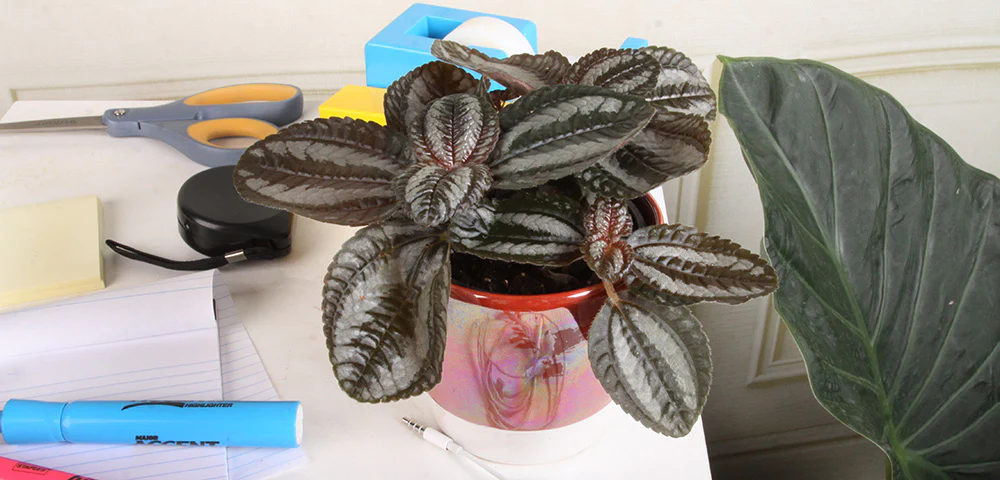
Pilea plants, such as the Pilea Peperomioides or “Chinese Money Plant,” are perfect for terrariums with their compact growth habit and unique round leaves.
- Light: Thrives in bright, indirect sunlight. Too much direct sun can scorch the leaves, while too little light may lead to leggy growth. A spot near an east- or north-facing window is ideal.
- Water: Keep the soil evenly moist but not soggy. Water when the top 1–2 inches of soil feel dry. Avoid letting the plant sit in excess water, as this can cause root rot.
- Humidity: Prefers moderate to high humidity but adapts well to normal indoor conditions. If the air is dry, occasional misting or placing it near a pebble tray can help.
- Temperature: Grows best in 60–75°F (16–24°C). Keep it away from cold drafts, heaters, and AC vents, which can stress the plant.
- Soil: Use a well-draining, lightweight potting mix. A blend with peat moss, perlite, and sand helps maintain proper drainage.
- Fertilizer: Feed with a balanced liquid fertilizer every 4–6 weeks during the growing season (spring and summer). Reduce feeding in fall and winter.
- Growth Habit: Compact, bushy growth with round, vibrant leaves that make it a perfect choice for terrariums and small indoor spaces.
- Bonus Tip: If the leaves start drooping, it’s likely due to underwatering. A good drink of water should perk it back up quickly! Also, rotate the plant occasionally to encourage even growth.
5. Polka Dot Plant (Hypoestes Phyllostachya)
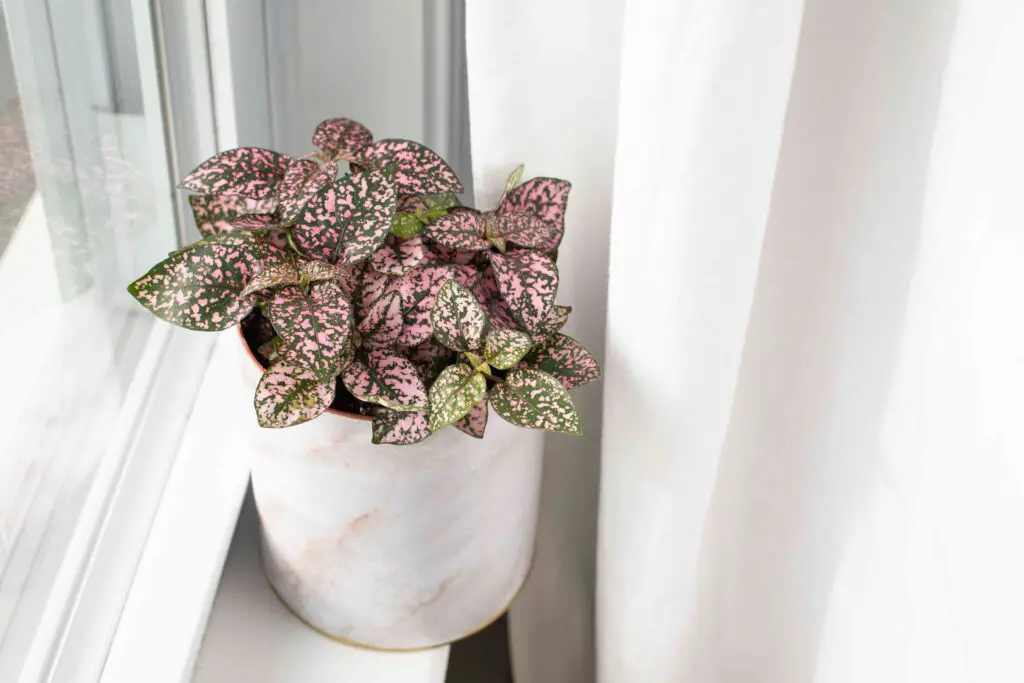
The colorful speckled leaves of the Polka Dot Plant bring joy to any terrarium. Its pink, red, or white patterns make it a standout choice.
- Light: Prefers bright, indirect light to maintain its vibrant leaf colors. Too much direct sunlight can cause fading, while too little light may make the plant leggy.
- Water: Keep the soil consistently moist but avoid waterlogging. Water when the top inch of soil feels dry. If the plant droops, it’s often a sign that it needs water.
- Humidity: Loves high humidity, making it a great choice for terrariums. Mist regularly or place near a humidifier to prevent leaf crisping.
- Temperature: Ideal range is 60–75°F (16–24°C). Avoid exposing it to cold drafts or sudden temperature changes.
- Soil: Requires a well-draining, nutrient-rich potting mix. A blend of peat moss, perlite, and standard potting soil works well.
- Fertilizer: Feed with a balanced liquid fertilizer every 4–6 weeks during the growing season to promote healthy growth and vibrant foliage.
- Growth Habit: Naturally compact but can become leggy over time. Pinch back the stems and remove flowers to encourage bushier, fuller growth.
- Bonus Tip: If your plant starts getting too tall and thin, it’s likely stretching for light—move it to a brighter location and continue pinching back stems for a fuller shape!
Related Topics:
6. Moss
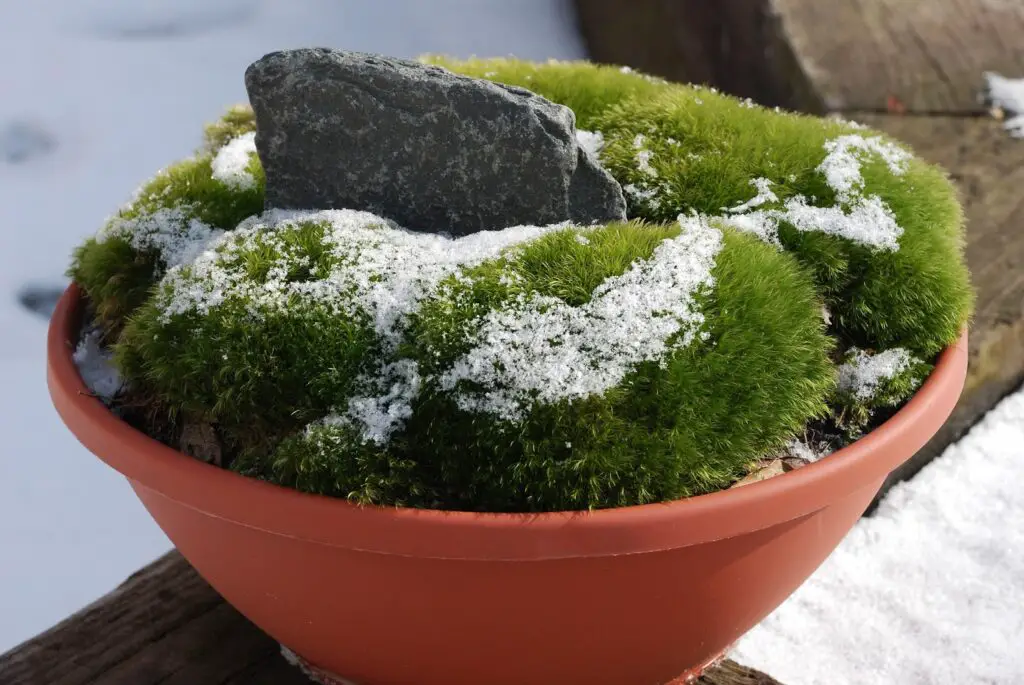
For a simple yet lush ground cover, moss is your go-to plant. It thrives on humidity and doesn’t require much sunlight, making it ideal for closed terrariums.
- Light: Thrives in low to moderate light. Indirect light or even shaded conditions work best. Too much direct sunlight can dry it out quickly.
- Water: Requires a consistently damp environment. Mist regularly or water gently to keep it moist, but avoid waterlogging. If it starts turning brown or dry, increase humidity and watering.
- Humidity: Loves high humidity, making it perfect for terrariums. A closed or partially covered terrarium helps retain moisture and create an ideal growing environment.
- Temperature: Prefers 50–75°F (10–24°C). Avoid placing it near heaters, air conditioners, or drafty areas that can cause it to dry out.
- Soil: Moss doesn’t require traditional soil; it thrives on moist surfaces like rocks, bark, or soil-rich substrates. Just ensure the surface stays damp.
- Fertilizer: Generally not needed. Moss absorbs nutrients from the environment, but if necessary, a diluted, organic liquid fertilizer can be used occasionally.
- Growth Habit: Forms a soft, lush carpet that spreads over surfaces, making it a great ground cover in terrariums.
- Bonus Tip: If your moss starts turning yellow or brown, it may be too dry. Increase misting and check for sufficient moisture to keep it green and thriving!
7. Spiderwort (Tradescantia)
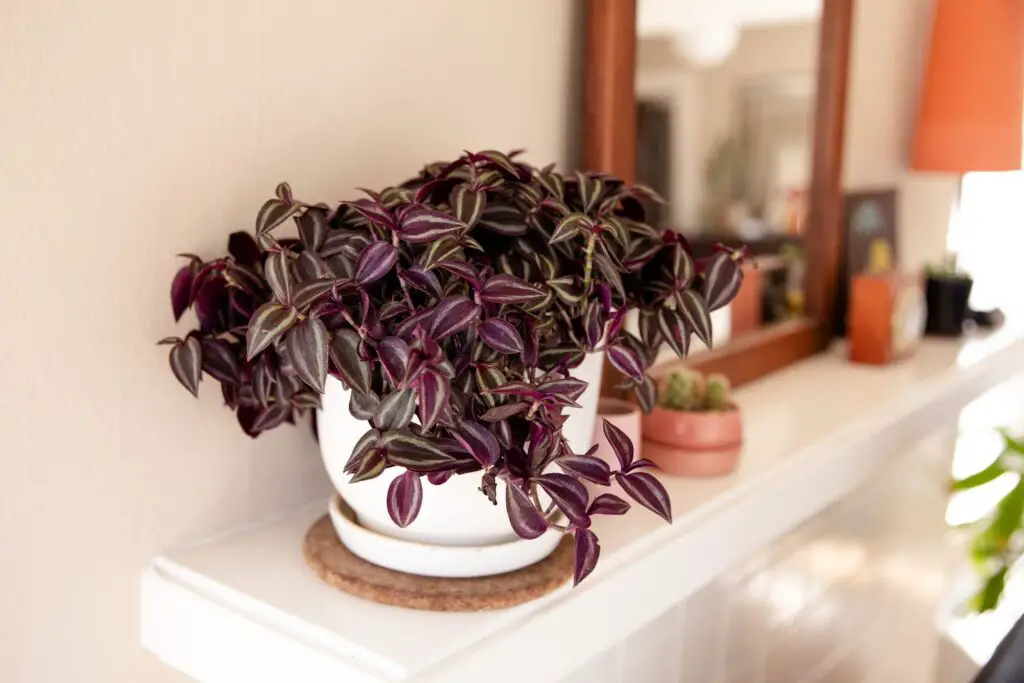
With its trailing stems and colorful leaves, Spiderwort is ideal for adding texture and draping effects in open terrariums.
- Light: Thrives in bright, indirect sunlight. Can tolerate some direct morning sun but avoid harsh afternoon rays, which can scorch the leaves. In lower light, the plant may lose its vibrant color.
- Water: Keep the soil evenly moist but not soggy. Water when the top inch of soil feels dry. Overwatering can cause root rot, while underwatering may lead to wilting.
- Humidity: Prefers moderate to high humidity but adapts well to normal indoor conditions. Occasional misting can help maintain its lush appearance.
- Temperature: Grows best in 60–80°F (16–27°C). Avoid placing it near cold drafts or heating vents, as extreme temperatures can stress the plant.
- Soil: Use a well-draining potting mix. A blend of peat moss, perlite, and standard potting soil works well to support healthy root growth.
- Fertilizer: Feed with a balanced liquid fertilizer every 4–6 weeks during the growing season (spring and summer) to encourage vibrant foliage.
- Growth Habit: A fast-growing trailing plant that can quickly outgrow its space. Prune regularly to control size, encourage bushier growth, and prevent legginess.
- Bonus Tip: If the plant becomes leggy or sparse, pinch back the stems to promote fuller, more compact growth. You can also propagate cuttings easily in water!
8. Maidenhair Fern (Adiantum)
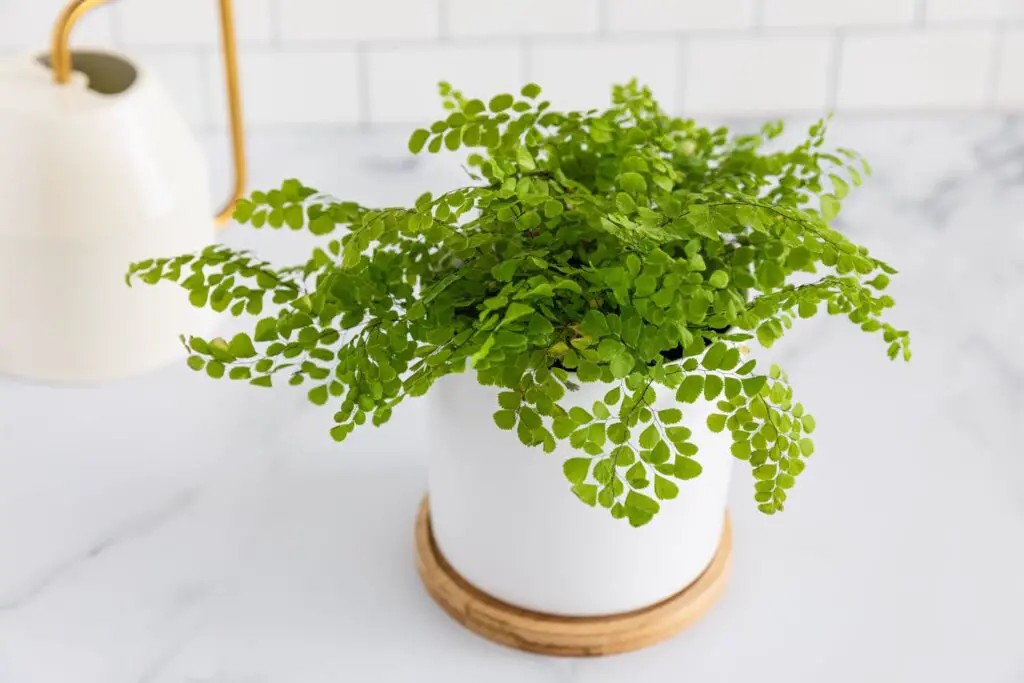
The soft, delicate foliage of Maidenhair Fern adds elegance to terrariums. It thrives in the humid conditions of closed containers.
- Light: Thrives in indirect sunlight. Prefers a bright, filtered light source but can tolerate low light. Avoid direct sun, which can scorch its delicate fronds.
- Water: Keep the soil consistently moist, but avoid waterlogging. Water when the top half-inch of soil feels dry. Never let the soil dry out completely, as the fern is very sensitive to drought.
- Humidity: Requires high humidity to thrive. Mist regularly, place near a humidifier, or keep it in a closed terrarium to maintain moisture levels.
- Temperature: Ideal range is 60–75°F (16–24°C). Avoid cold drafts, heaters, and air conditioning vents, which can dry out the plant.
- Soil: Prefers a light, well-draining mix rich in organic matter. A blend of peat moss, perlite, and potting soil works well to retain moisture while preventing root rot.
- Fertilizer: Feed with a diluted liquid fertilizer every 4–6 weeks during the growing season (spring and summer). Avoid over-fertilizing, as this can damage the delicate roots.
- Growth Habit: A graceful, feathery fern with arching fronds that create a soft, elegant look. Its fine texture makes it a perfect choice for terrariums.
- Bonus Tip: If the fronds turn brown or crispy, it’s a sign of low humidity or underwatering. Increase misting and keep the soil consistently damp to revive the plant!
9. Elephant Bush (Portulacaria Afra)

A small succulent, Elephant Bush works well in open terrariums. Its thick, glossy leaves store water, requiring minimal maintenance.
- Light: Thrives in full to partial sunlight. Prefers at least 4–6 hours of bright light daily. Indoors, place it near a sunny window, preferably south- or west-facing.
- Water: Water sparingly—only when the soil is completely dry. Overwatering can cause root rot. In warmer months, water every 2–3 weeks, and reduce watering in winter.
- Humidity: Tolerates low humidity well. No need for misting, as it naturally retains moisture in its thick, succulent leaves.
- Temperature: Prefers 65–85°F (18–29°C). Protect from temperatures below 50°F (10°C), as it is sensitive to cold and frost.
- Soil: Requires fast-draining, sandy or succulent soil. A cactus or succulent mix with added perlite or sand helps prevent excess moisture retention.
- Fertilizer: Feed with a diluted cactus fertilizer every 4–6 weeks during the growing season (spring and summer). No fertilizing is needed in fall and winter.
- Growth Habit: A slow-growing, bushy succulent that can trail or grow upright. Perfect for terrariums with good airflow.
- Bonus Tip: If leaves start dropping, it’s usually a sign of overwatering. Let the soil dry out completely before the next watering to keep the plant healthy!
10. Peperomia
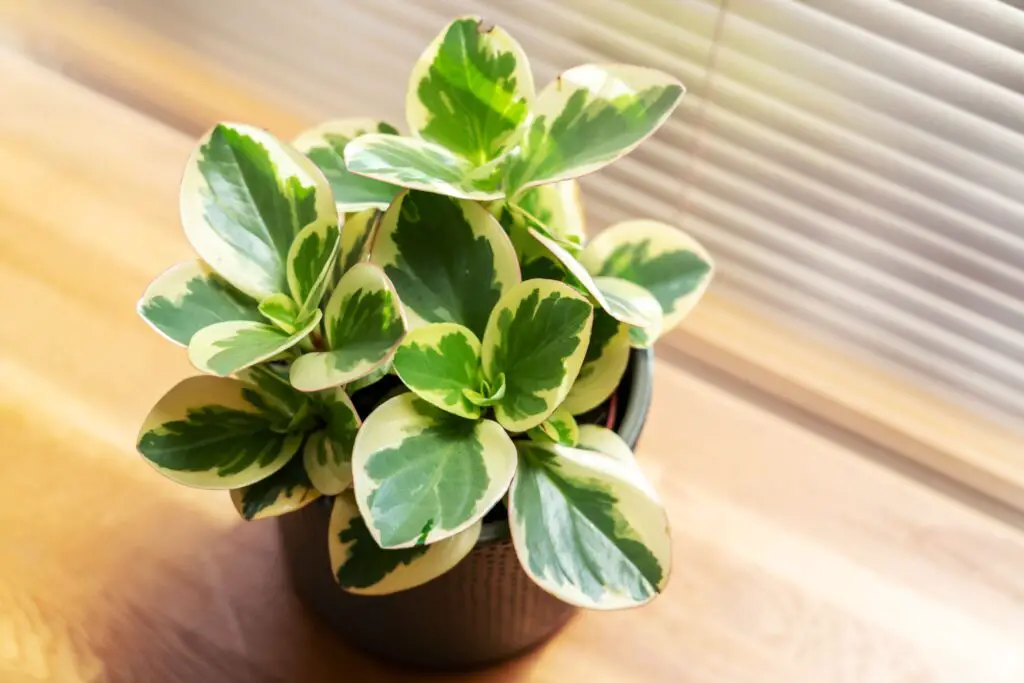
Peperomia plants are a versatile choice, with compact structures and a variety of leaf shapes and colors. They fit beautifully into smaller terrariums.
- Light: Prefers medium to bright, indirect sunlight. Can tolerate lower light, but growth may slow. Avoid direct sunlight, which can scorch the leaves.
- Water: Allow soil to dry slightly between watering. Water when the top 1–2 inches of soil feel dry. Overwatering can lead to root rot, so it’s better to underwater than overwater.
- Humidity: Enjoys moderate to high humidity, but adapts well to normal indoor levels. Occasional misting can help, especially in drier climates.
- Temperature: Thrives in 65–80°F (18–27°C). Keep away from cold drafts, heating vents, and AC units.
- Soil: Prefers a well-draining, light potting mix. A blend of peat moss, perlite, and standard potting soil works well to prevent excess moisture retention.
- Fertilizer: Feed with a diluted liquid fertilizer every 4–6 weeks during the growing season (spring and summer). Avoid over-fertilizing, as Peperomias are slow growers.
- Growth Habit: Compact and bushy with thick, water-storing leaves, making it a great plant for small spaces and terrariums.
- Bonus Tip: If leaves start wilting or curling, it may be a sign of underwatering, while yellowing leaves often indicate overwatering. Adjust watering accordingly to keep it thriving!
11. Button Fern (Pellaea Rotundifolia)
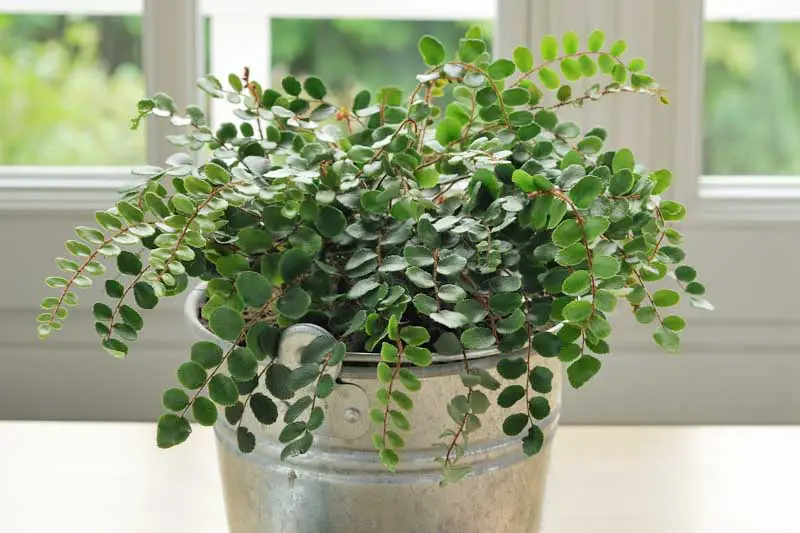
This dainty fern’s round, leathery leaves make it a favorite for closed terrariums. It prefers cool, humid environments.
- Light: Prefers partial to full shade. Thrives in low to moderate indirect light, making it an excellent choice for terrariums or low-light indoor spaces. Avoid direct sunlight, which can scorch its delicate fronds.
- Water: Keep the soil lightly moist but not soggy. Water when the top inch of soil feels dry. Avoid overwatering, as Button Ferns are more drought-tolerant than other ferns and susceptible to root rot.
- Humidity: Prefers moderate to high humidity but can tolerate drier air better than most ferns. Regular misting or placing it in a terrarium helps maintain ideal humidity levels.
- Temperature: Grows best in 60–75°F (16–24°C). Avoid placing near cold drafts, heaters, or AC vents, which can dry out the plant.
- Soil: Requires a well-draining, loose potting mix. A blend of peat moss, perlite, and potting soil helps maintain the right moisture balance.
- Fertilizer: Feed with a diluted liquid fertilizer every 4–6 weeks during the growing season (spring and summer) to support healthy growth. Reduce feeding in fall and winter.
- Growth Habit: A small, compact fern with delicate, rounded leaflets on arching stems, making it a charming addition to terrariums and indoor spaces.
- Bonus Tip: If the fronds start turning yellow or brown, check for overwatering or low humidity. Adjust care accordingly to keep the foliage lush and healthy!
12. Miniature Orchids
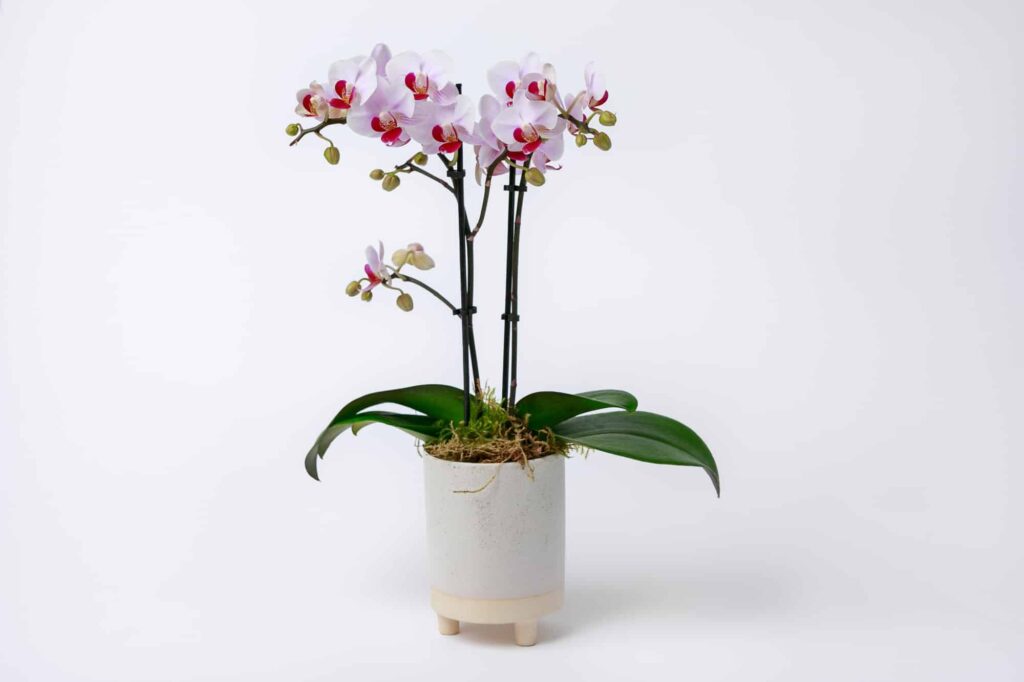
Mini Orchids bring a pop of elegance and color to open terrariums. Their small size and delicate flowers create a stunning visual impact.
- Light: Thrive in bright, indirect light. A north- or east-facing window is ideal. Too much direct sun can scorch the leaves, while too little light may reduce flowering.
- Water: Water sparingly, allowing the growing medium to dry slightly between waterings. Most miniature orchids prefer to be watered about once a week, but this varies depending on humidity levels.
- Humidity: Require high humidity (50–80%) to thrive. Mist regularly or place near a humidifier to maintain moisture levels, especially in dry climates.
- Temperature: Prefer 65–80°F (18–27°C). Avoid cold drafts and sudden temperature fluctuations, as orchids can be sensitive to changes.
- Soil: Do best in a well-draining orchid mix made of bark, sphagnum moss, and perlite. Avoid standard potting soil, as it retains too much moisture.
- Fertilizer: Use a diluted orchid fertilizer every 2–4 weeks during the growing season to support blooming and growth. Reduce feeding in fall and winter.
- Growth Habit: Small and delicate, these orchids produce exquisite blooms while remaining compact—perfect for terrariums or small indoor spaces.
- Bonus Tip: If leaves start wrinkling or wilting, increase humidity and check watering frequency. Proper airflow is also essential to prevent rot and fungal issues!
13. Earth Star (Cryptanthus)
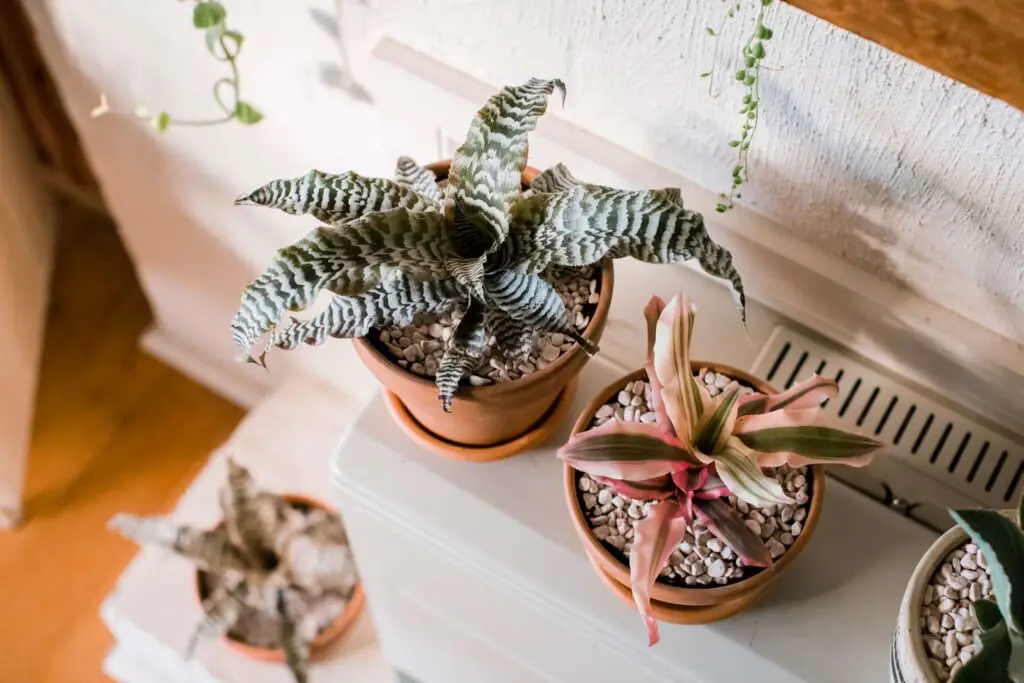
With its bold, rosette-shaped foliage, Earth Star adds texture and a splash of pink or red to your terrarium.
- Light: Prefers medium to bright, indirect sunlight. Can tolerate some direct morning sun, which enhances its vibrant colors. Too much shade may cause fading.
- Water: Avoid oversaturation—water only when the top inch of soil is dry. Overwatering can lead to root rot. It prefers a lightly moist but well-draining environment.
- Humidity: Thrives in moderate to high humidity, making it an excellent terrarium plant. If grown in dry indoor air, mist occasionally or place near a pebble tray.
- Temperature: Best suited for 60–80°F (16–27°C). Protect from cold drafts and sudden temperature drops, as it is sensitive to chilly conditions.
- Soil: Requires a well-draining, slightly acidic mix. A combination of peat moss, sand, and perlite works well to prevent excess moisture retention.
- Fertilizer: Feed with a diluted liquid fertilizer every 4–6 weeks during the growing season to promote healthy growth and vibrant foliage.
- Growth Habit: A low-growing, star-shaped plant with colorful, textured leaves, making it a striking addition to terrariums and small indoor gardens.
- Bonus Tip: If leaves lose color or appear stretched, the plant may need more light. Move it to a brighter spot while avoiding harsh, direct sun!
14. English Ivy (Hedera Helix)
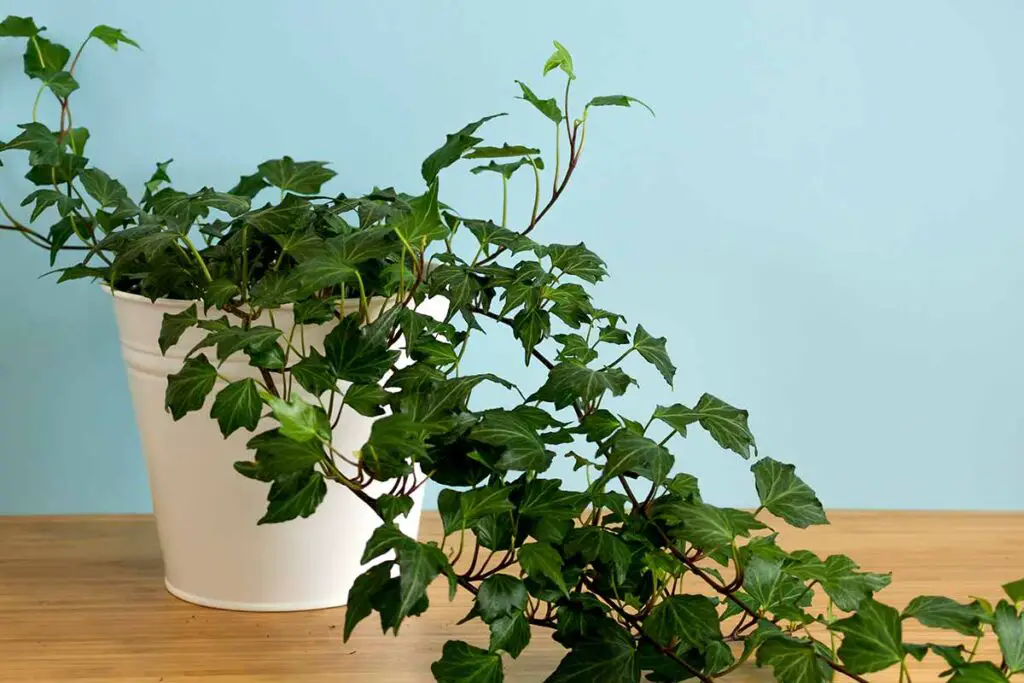
English Ivy is a hardy climber that works well for open terrariums, adding a trailing effect to your container garden.
- Light: Adapts well to low to bright, indirect light. Prefers moderate light for best growth, but can tolerate lower light conditions. Too much direct sun can scorch its leaves.
- Water: Keep the soil evenly moist but not soggy. Water when the top inch of soil feels dry. Overwatering can lead to root rot, while underwatering may cause leaf drop.
- Humidity: Prefers moderate to high humidity. If grown indoors, mist occasionally or place near a humidifier to prevent leaf crisping.
- Temperature: Thrives in 50–75°F (10–24°C). Can tolerate cooler temperatures but should be kept away from heaters, drafts, and AC vents.
- Soil: Prefers a well-draining, rich potting mix. A blend of peat moss, perlite, and standard potting soil works well.
- Fertilizer: Feed with a balanced liquid fertilizer every 4–6 weeks during the growing season (spring and summer) to encourage lush growth. Reduce feeding in fall and winter.
- Growth Habit: A trailing or climbing vine that can spread quickly. Ideal for terrariums, hanging baskets, or as a cascading plant.
- Bonus Tip: Prune often to control its size and encourage bushier growth. If stems become leggy, trim them back to promote a fuller appearance!
15. Prayer Plant (Maranta Leuconeura)
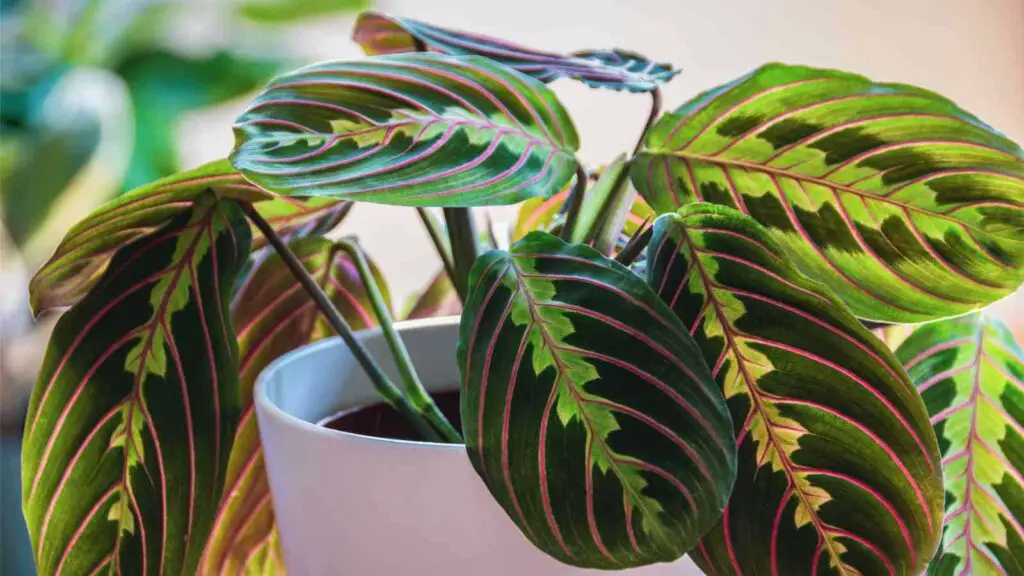
The Prayer Plant is famous for its beautiful, patterned foliage and its unique habit of folding its leaves at night. It’s a fantastic addition to both open and closed terrariums.
- Light: Thrives in low to medium indirect light. Can tolerate lower light but grows best in moderate filtered light. Avoid direct sun, which can fade its vibrant leaf patterns.
- Water: Keep soil moist but not soggy. Water when the top half-inch of soil feels dry. Use lukewarm, filtered water to avoid mineral buildup, which can harm the plant.
- Humidity: Prefers high humidity. Mist regularly, place near a humidifier, or use a pebble tray to maintain moisture levels, especially in drier climates.
- Temperature: Grows best in 65–80°F (18–27°C). Avoid cold drafts, heaters, and AC vents, as temperature fluctuations can stress the plant.
- Soil: Requires a well-draining, peat-based potting mix. A combination of peat moss, perlite, and standard potting soil works well to retain moisture without becoming waterlogged.
- Fertilizer: Feed with a diluted liquid fertilizer every 4–6 weeks during spring and summer for healthy growth. Reduce feeding in fall and winter.
- Growth Habit: A low-growing, spreading plant with beautifully patterned leaves that fold up at night, resembling praying hands.
- Bonus Tip: If leaf tips turn brown, it may indicate low humidity or tap water chemicals. Increase humidity and use distilled or rainwater for best results!
How to Choose the Right Plants for Your Terrarium?
When selecting plants, consider these factors:
- Light Requirements: Ensure all plants in your terrarium have similar light needs.
- Humidity Levels: Closed terrariums require moisture-loving plants, while open terrariums work best with drier species.
- Growth Rate: Choose plants with slow growth to avoid overcrowding.
- Size: Opt for smaller plants that fit comfortably in the terrarium.
Terrarium Care Tips:
- Water Wisely: Overwatering is the enemy! Keep the moisture level in check.
- Prune Regularly: Trim back any overgrowth to maintain the aesthetics of your terrarium.
- Cleanliness Is Key: Wipe down the glass and remove any dead foliage to prevent mold.
Terrariums bring nature indoors and allow you to experiment with countless plant combinations. Choose from this list of the best plants for terrariums, and get ready to create your personal botanical masterpiece!
Creating a terrarium is a fun and rewarding way to bring a touch of nature indoors. With the right plants, you can build a low-maintenance, self-sustaining ecosystem that adds beauty and tranquility to any space. From moisture-loving ferns to hardy succulents and vibrant foliage plants, the 15 best plants for terrariums offer a variety of options to suit different styles and conditions.
Whether you prefer a lush, tropical look with ferns and moss or a drier, open terrarium with succulents, selecting the right plants and providing proper care will ensure your miniature garden thrives. With the right balance of light, water, and humidity, your terrarium can be a long-lasting and visually stunning centerpiece for your home or office.
So, get creative and start building your own little green world today!
FAQs:
What are the best low-maintenance plants for a terrarium?
Low-maintenance options include Moss, Air Plants (Tillandsia), and Nerve Plants (Fittonia). These plants thrive in high humidity and require minimal care, making them ideal for closed terrariums.
Do terrarium plants need direct sunlight?
No, most terrarium plants prefer indirect or filtered light. Direct sunlight can create excessive heat and condensation inside the terrarium, potentially harming the plants. Bright, indirect light is ideal.
How do I prevent mold and rot in my terrarium?
To prevent mold and root rot, avoid overwatering, ensure good air circulation, and use a well-draining substrate with layers of gravel, charcoal, and soil. Also, keep the terrarium lid slightly open occasionally to allow excess moisture to escape.
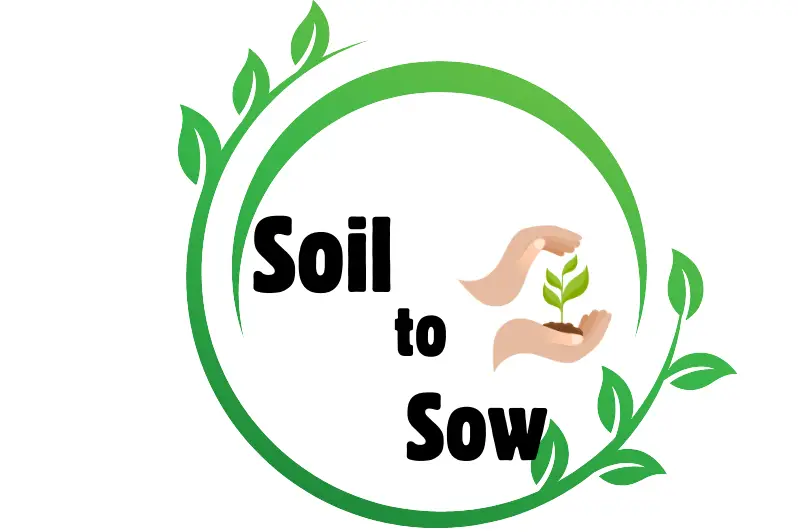
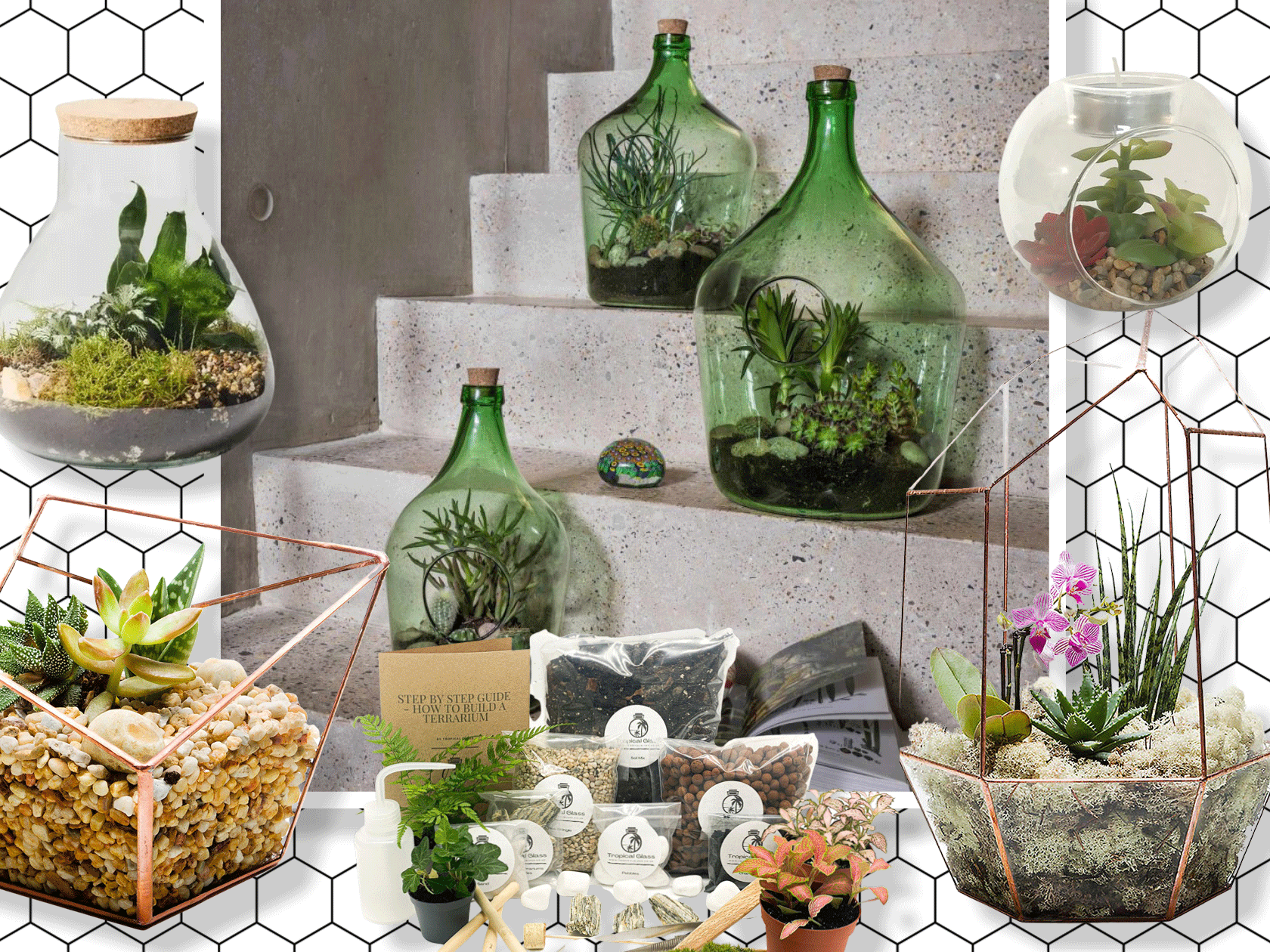
2 thoughts on “15 Best Plants for Terrariums: Greenery for Stunning Mini Ecosystems!”